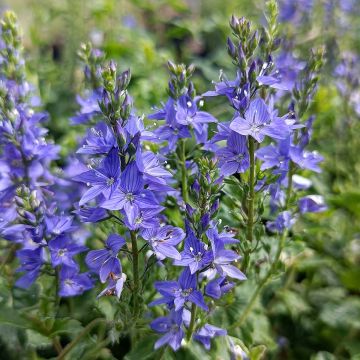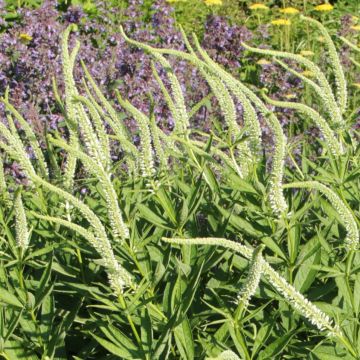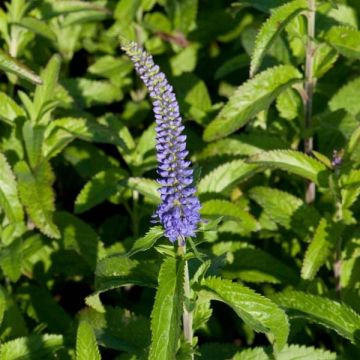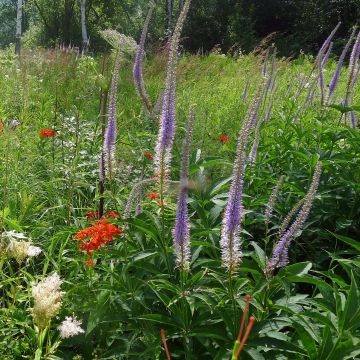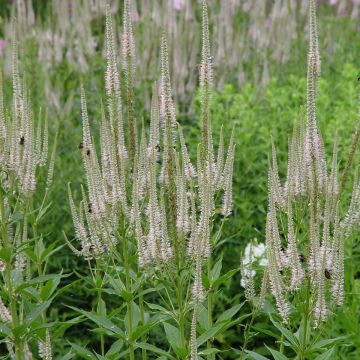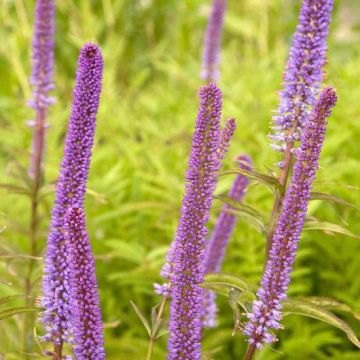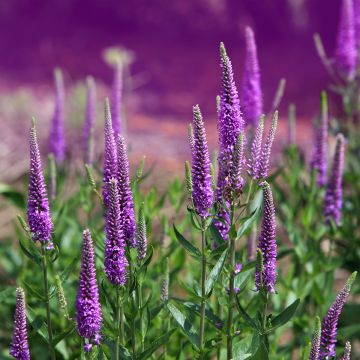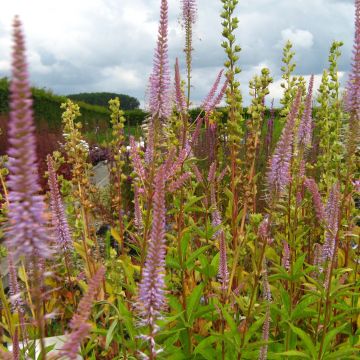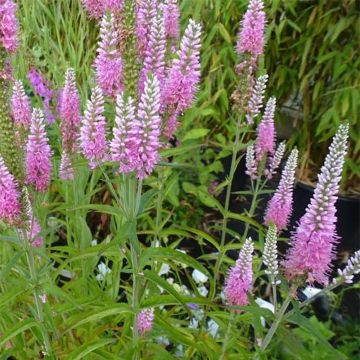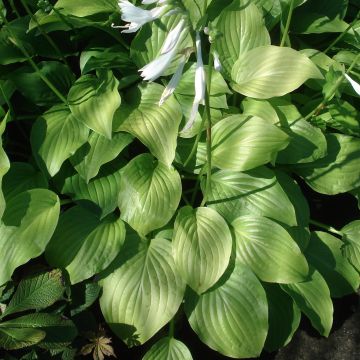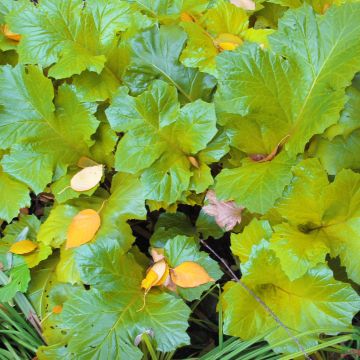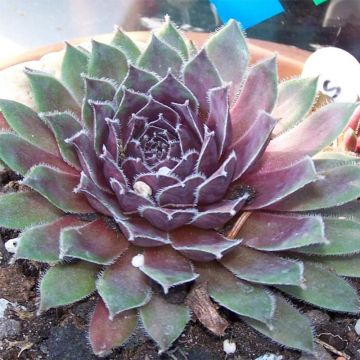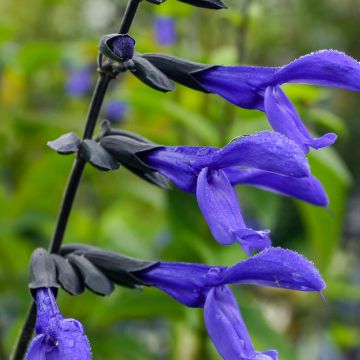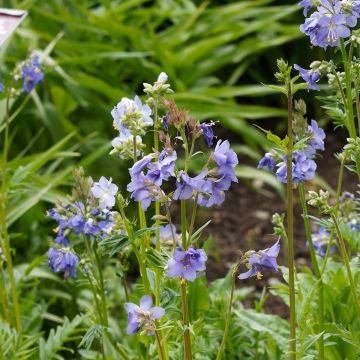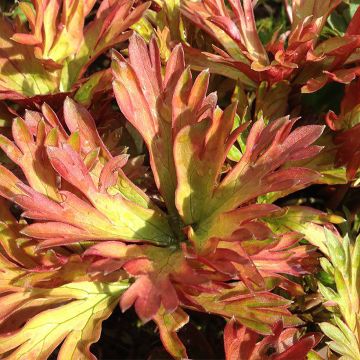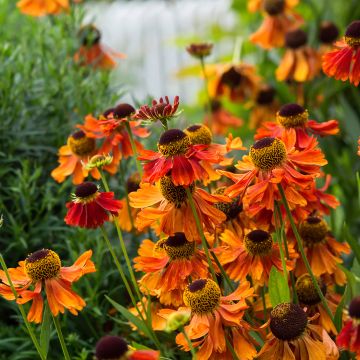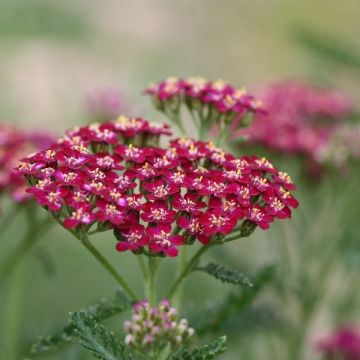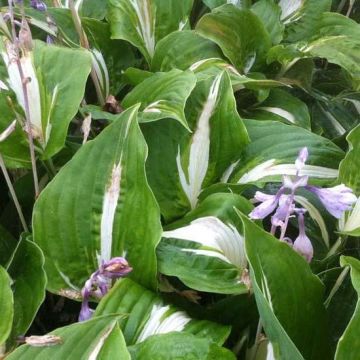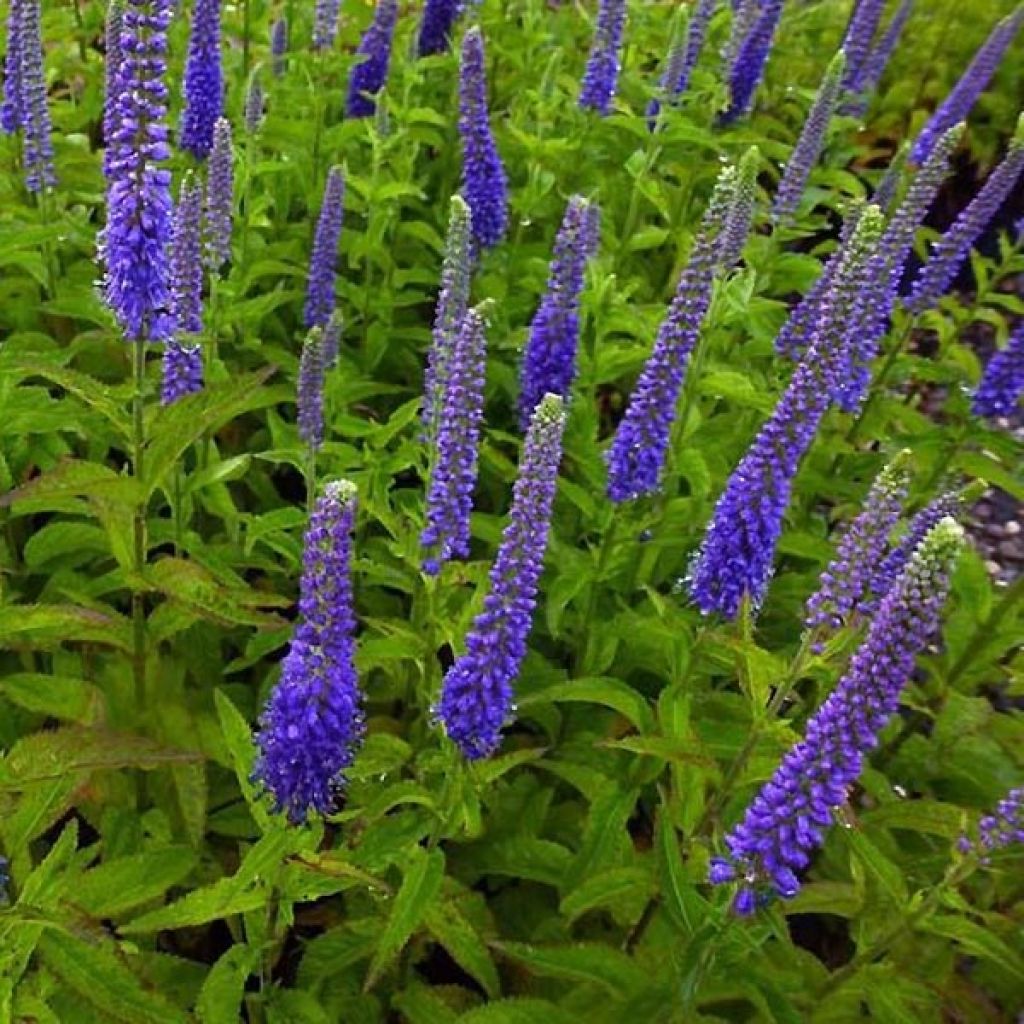

Veronica Sunny Border Blue
Veronica Sunny Border Blue
Veronica Sunny Border Blue
Spiked Speedwell
This item cannot be shipped to the selected country
Delivery charge from €5.90
More information
Schedule delivery date,
and select date in basket
This plant carries a 12 months recovery warranty
More information
We guarantee the quality of our plants for a full growing cycle, and will replace at our expense any plant that fails to recover under normal climatic and planting conditions.
From €5.90 for pickup delivery and €6.90 for home delivery
Express home delivery from €8.90.

Does this plant fit my garden?
Set up your Plantfit profile →
Description
Veronica 'Sunny Border Blue' is a very popular hybrid Veronica variety, introduced in 1946. This vigorous deciduous to semi-evergreen perennial offers upright, compact and dense spikes of small blue-violet flowers in summer. It forms spreading clumps with greyish and villous foliage, which spreads thanks to a strong creeping stump. It thrives in sunny beds with well-drained limestone soil. Its flowers are perfect for bouquets.
The Veronica 'Sunny Border Blue', also known as Veronica spicata 'Sunny Border Blue', from the Plantaginaceae family, formerly classified in the Scrophulariaceae family, is a variety derived from Veronica spicata or spike speedwell. This perennial plant mainly grows in the mountains, up to 2000 meters (6500 feet) altitude. It can also be found in meadows, dry grasslands, rocky slopes, at the edge of forests, most of the time on limestone soil.
The Sunny Border Blue form shows dense and vigorous vegetation, 30 to 45cm (12 to 18in) tall for the foliage, 50cm (20in) tall when flowering, spreading over a diameter of 50cm (20in) from its powerful semi-woody stump. Its villous stems are branched in the upper part and bear deciduous to semi-evergreen ovate to linear leaves, with finely dentate edges, in a beautiful dark green colour. In summer, from June to August and sometimes until September, it produces tiny star-shaped blue-violet flowers, green at the top of each spike, tightly packed on dense and upright flower spikes. This flowering is nectar-rich. The plant self-seeds spontaneously in light soil.
This Sunny Border Blue spike speedwell can be planted in any well-drained soil, even rocky and limestone, preferably in full sun. It is particularly suitable for a mountain garden with rocky soil. While it prefers some moisture at its base, once well established, it tolerates drought fairly well. This perennial will be very useful for dressing the base of shrub roses or in an elevated bed, on a slope, in a rockery, combined with echinaceas, stipas, red shrubby salvias, Californian poppies or lavender. Its blue spikes add height and colour to a low-growing mass composed of very spreading plants such as aubrietas, wall bellflowers or cerastiums. The spiked speedwell can also be showcased as a standalone plant. Its flowers are also very beautiful in summer bouquets.
Report an error about the product description
Veronica Sunny Border Blue in pictures
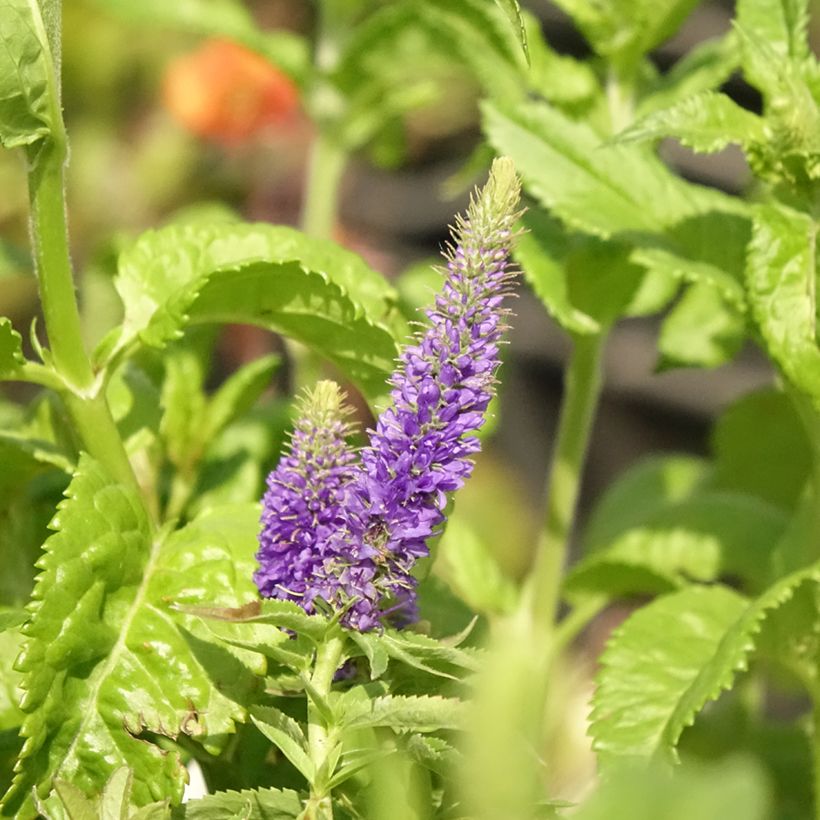

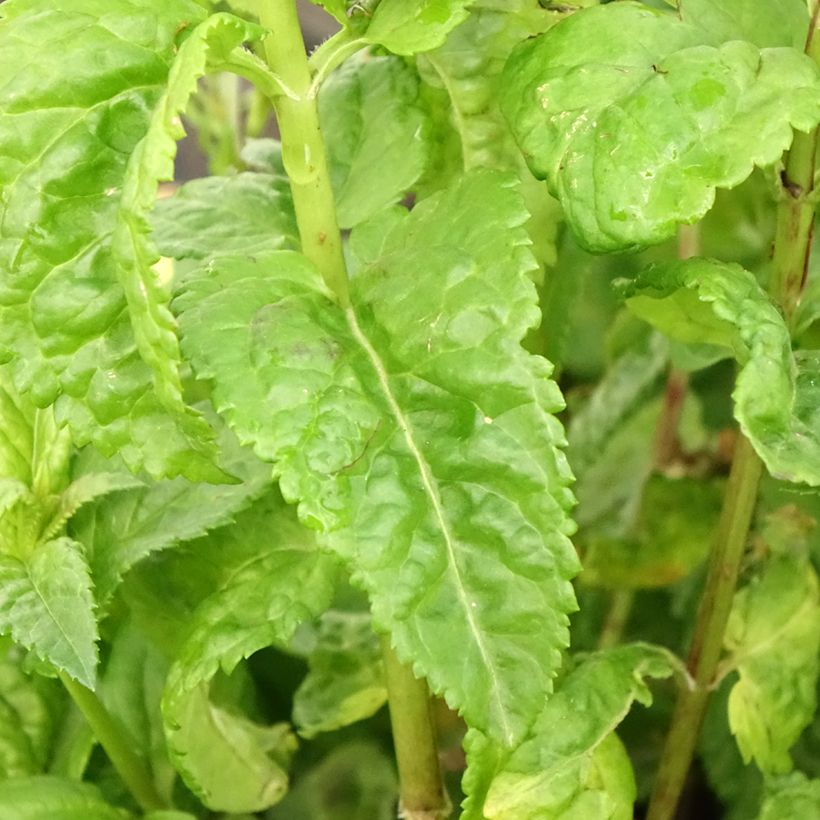

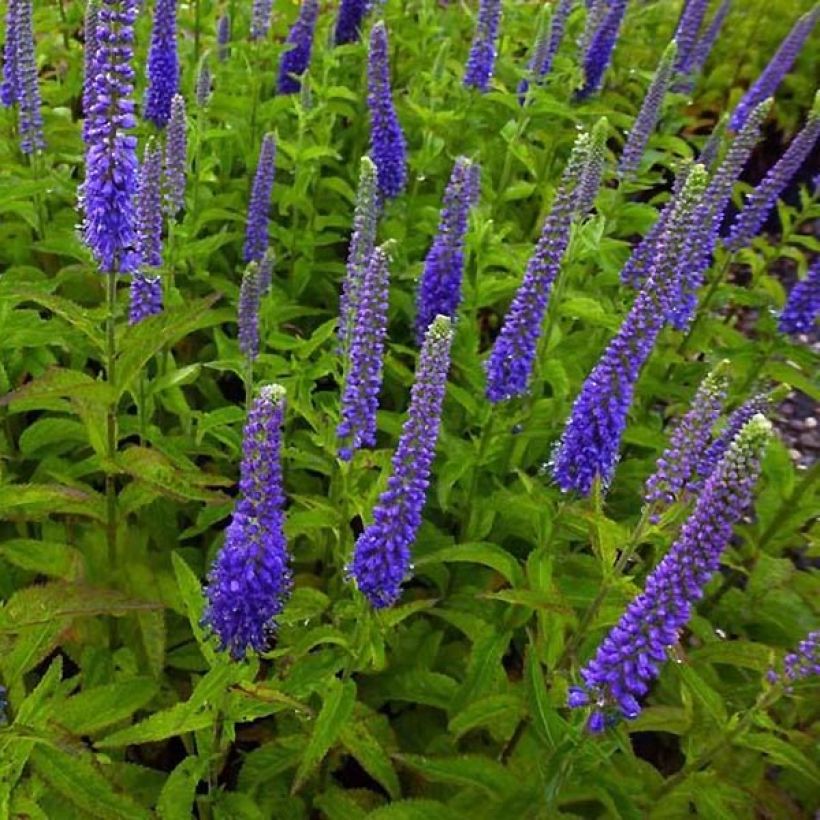

Flowering
Foliage
Plant habit
Botanical data
Veronica
Sunny Border Blue
Plantaginaceae
Spiked Speedwell
Cultivar or hybrid
Other Veronica - Speedwell
Planting and care
The spiked speedwell Sunny Border Blue is a sun-loving and poor soil plant. Its preferred habitat is limestone soil, rather dry and rocky or gravelly, and properly drained. It dislikes stagnant moisture in winter, much more than the cold. You can cut back the faded stems, which have a brownish appearance. Indeed, the dried-out stems are not always aesthetic, so it is preferable to remove them, which will also promote the resumption of flowering. You can also let a few plants self-sow, the plants resulting from these spontaneous sowings will not always be identical to the parent plant. In any case, the clumps should be cut back in spring before the emergence of vegetation.
Planting period
Intended location
Care
-
, onOrder confirmed
Reply from on Promesse de fleurs
Summer flowering perennials
Haven't found what you were looking for?
Hardiness is the lowest winter temperature a plant can endure without suffering serious damage or even dying. However, hardiness is affected by location (a sheltered area, such as a patio), protection (winter cover) and soil type (hardiness is improved by well-drained soil).

Photo Sharing Terms & Conditions
In order to encourage gardeners to interact and share their experiences, Promesse de fleurs offers various media enabling content to be uploaded onto its Site - in particular via the ‘Photo sharing’ module.
The User agrees to refrain from:
- Posting any content that is illegal, prejudicial, insulting, racist, inciteful to hatred, revisionist, contrary to public decency, that infringes on privacy or on the privacy rights of third parties, in particular the publicity rights of persons and goods, intellectual property rights, or the right to privacy.
- Submitting content on behalf of a third party;
- Impersonate the identity of a third party and/or publish any personal information about a third party;
In general, the User undertakes to refrain from any unethical behaviour.
All Content (in particular text, comments, files, images, photos, videos, creative works, etc.), which may be subject to property or intellectual property rights, image or other private rights, shall remain the property of the User, subject to the limited rights granted by the terms of the licence granted by Promesse de fleurs as stated below. Users are at liberty to publish or not to publish such Content on the Site, notably via the ‘Photo Sharing’ facility, and accept that this Content shall be made public and freely accessible, notably on the Internet.
Users further acknowledge, undertake to have ,and guarantee that they hold all necessary rights and permissions to publish such material on the Site, in particular with regard to the legislation in force pertaining to any privacy, property, intellectual property, image, or contractual rights, or rights of any other nature. By publishing such Content on the Site, Users acknowledge accepting full liability as publishers of the Content within the meaning of the law, and grant Promesse de fleurs, free of charge, an inclusive, worldwide licence for the said Content for the entire duration of its publication, including all reproduction, representation, up/downloading, displaying, performing, transmission, and storage rights.
Users also grant permission for their name to be linked to the Content and accept that this link may not always be made available.
By engaging in posting material, Users consent to their Content becoming automatically accessible on the Internet, in particular on other sites and/or blogs and/or web pages of the Promesse de fleurs site, including in particular social pages and the Promesse de fleurs catalogue.
Users may secure the removal of entrusted content free of charge by issuing a simple request via our contact form.
The flowering period indicated on our website applies to countries and regions located in USDA zone 8 (France, the United Kingdom, Ireland, the Netherlands, etc.)
It will vary according to where you live:
- In zones 9 to 10 (Italy, Spain, Greece, etc.), flowering will occur about 2 to 4 weeks earlier.
- In zones 6 to 7 (Germany, Poland, Slovenia, and lower mountainous regions), flowering will be delayed by 2 to 3 weeks.
- In zone 5 (Central Europe, Scandinavia), blooming will be delayed by 3 to 5 weeks.
In temperate climates, pruning of spring-flowering shrubs (forsythia, spireas, etc.) should be done just after flowering.
Pruning of summer-flowering shrubs (Indian Lilac, Perovskia, etc.) can be done in winter or spring.
In cold regions as well as with frost-sensitive plants, avoid pruning too early when severe frosts may still occur.
The planting period indicated on our website applies to countries and regions located in USDA zone 8 (France, United Kingdom, Ireland, Netherlands).
It will vary according to where you live:
- In Mediterranean zones (Marseille, Madrid, Milan, etc.), autumn and winter are the best planting periods.
- In continental zones (Strasbourg, Munich, Vienna, etc.), delay planting by 2 to 3 weeks in spring and bring it forward by 2 to 4 weeks in autumn.
- In mountainous regions (the Alps, Pyrenees, Carpathians, etc.), it is best to plant in late spring (May-June) or late summer (August-September).
The harvesting period indicated on our website applies to countries and regions in USDA zone 8 (France, England, Ireland, the Netherlands).
In colder areas (Scandinavia, Poland, Austria...) fruit and vegetable harvests are likely to be delayed by 3-4 weeks.
In warmer areas (Italy, Spain, Greece, etc.), harvesting will probably take place earlier, depending on weather conditions.
The sowing periods indicated on our website apply to countries and regions within USDA Zone 8 (France, UK, Ireland, Netherlands).
In colder areas (Scandinavia, Poland, Austria...), delay any outdoor sowing by 3-4 weeks, or sow under glass.
In warmer climes (Italy, Spain, Greece, etc.), bring outdoor sowing forward by a few weeks.

































